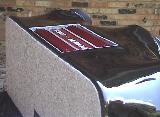How Thick Should Your Fiberglass Enclosure Be?
One of the most frequent questions I receive by email and that I see on the car audio forums has to do with fiberglass thickness. Specifically the thickness of a fiberglass subwoofer enclosure. There's a lot of confusion over how thick or how many layers of fiberglass should be used to create a car audio subwoofer box. The purpose of this article is to clear up some of the confusion.
There is a lot of debate in fiberglassing over the thickness needed. You really have to be careful who you listen to. I've basically heard everything up to about one inch of thickness. It's usually from newbies who are just guessing based on what they know about MDF thickness for enclosures. Unfortunately that thinking doesn't hold up in the real world. The real answer is complicated and it needs to be based on the size of the entire enclosure, power going to the woofer(s) and amount and number of curves in the enclosure. There is no formula that will tell you how thick or how many layers you will need for a given woofer size or amplifier rating.
The larger the enclosure the more thickness you will likely need. The same goes for power going to the subs. The more power you apply the more pressure will be exerted on the enclosure walls. Pressure caused by the subwoofer movement (powered by the amplifier) is what dictates how the thick the enclosure will be. Thickness is not determined by the number or size of the woofers. You can put (4) 15" woofers into an enclosure and if they're each getting 1 watt you don't need very thick walls at all because there is little pressure.
Curves are the trickiest part because they're difficult to measure. How exactly do you measure the "curviness"? You have to go by experience here. My rule of thumb for thickening subwoofer enclosures is a real rule of thumb. After the enclosure has cured I test it by pushing on various areas of the enclosure with my thumb. If I find a spot that flexes I know it needs more thickening. Pushing hard on such a small area will exert much more pressure (force/area) than a subwoofer. If the enclosure flexes you know that you will need more stiffening by adding more layers of fiberglass. How many more? Until the enclosure stops flexing (after curing). Since there are different weights of fiberglass mat there is no way to say how many layers you will need. Are you using 1oz, 1.5oz, 2oz, etc.? Keep adding layers until the subwoofer box is as strong as your thumb test. Be sure to test all areas of the enclosure.
The flatter areas are what you need to be concerned with the most. A curved area can withstand pressure much better than a flat area. Have you ever seen those tanks in oil refineries that look like large globes? Those tanks hold high pressure LPG (liquid petroleum gas) and the reason they are shaped like a ball is because that is the most efficient shape for holding pressure. A flat walled tank under the same pressure would need to be so thick that it would be impractical to construct it. A sphere is the most perfect shape for a pressure vessel whether it be an LPG tank or a subwoofer enclosure. This is also why you want to use MDF for large, flat areas on your enclosure. MDF is very rigid and it is much faster and cheaper to create a flat panel with MDF than it is with fiberglass.
Bottom line: Fiberglass enclosure thickness is based on many factors and no one can tell you how many layers or how thick your subwoofer box should be because all enclosures are unique.

You should check out Fiberglass Fabrication I. It covers an introduction to fiberglass work with sections on kick panel speakers pods, MDF enclosures with curved fiberglass baffles and spare tire subwoofer enclosures. Click here.

For those with fiberglass experience or who want to create more advanced fiberglass projects Fiberglass Fabrication II has just been released. It shows you how to create vehicle molded subwoofer enclosures, multiple woofer/amp rack combinations and custom door panels. Click here.
Both DVDs are available together at a special price.
Back to the Newsletter Archives Index